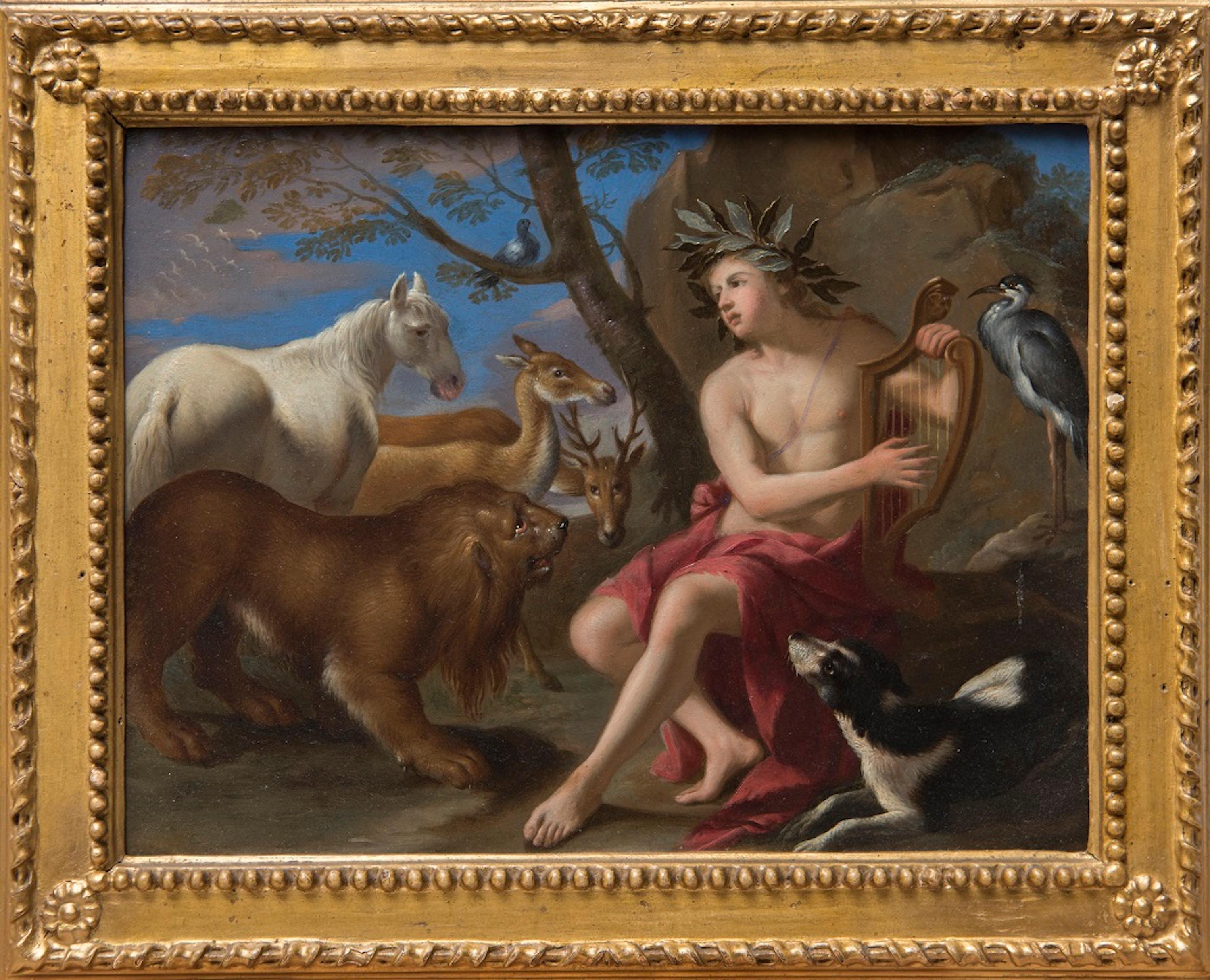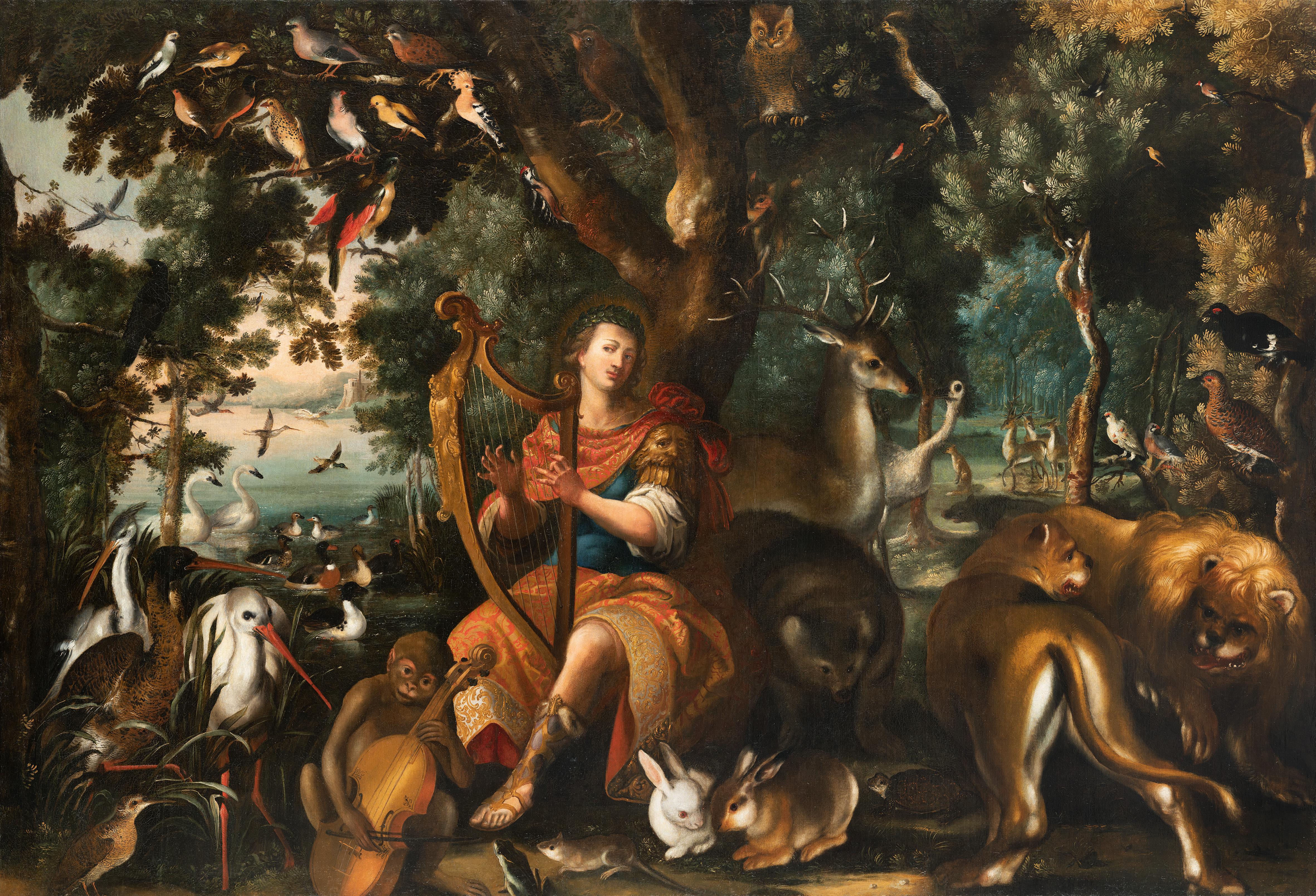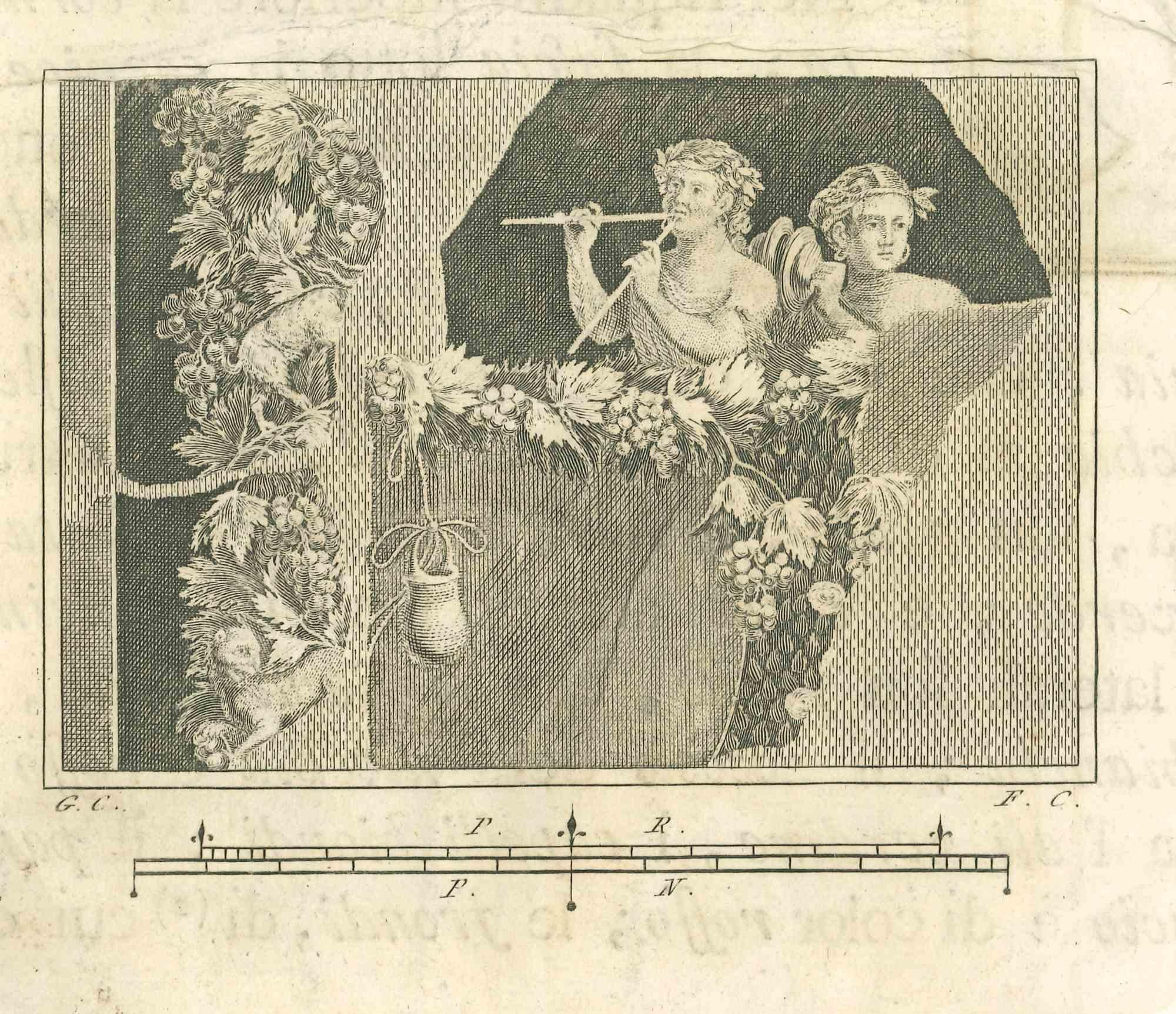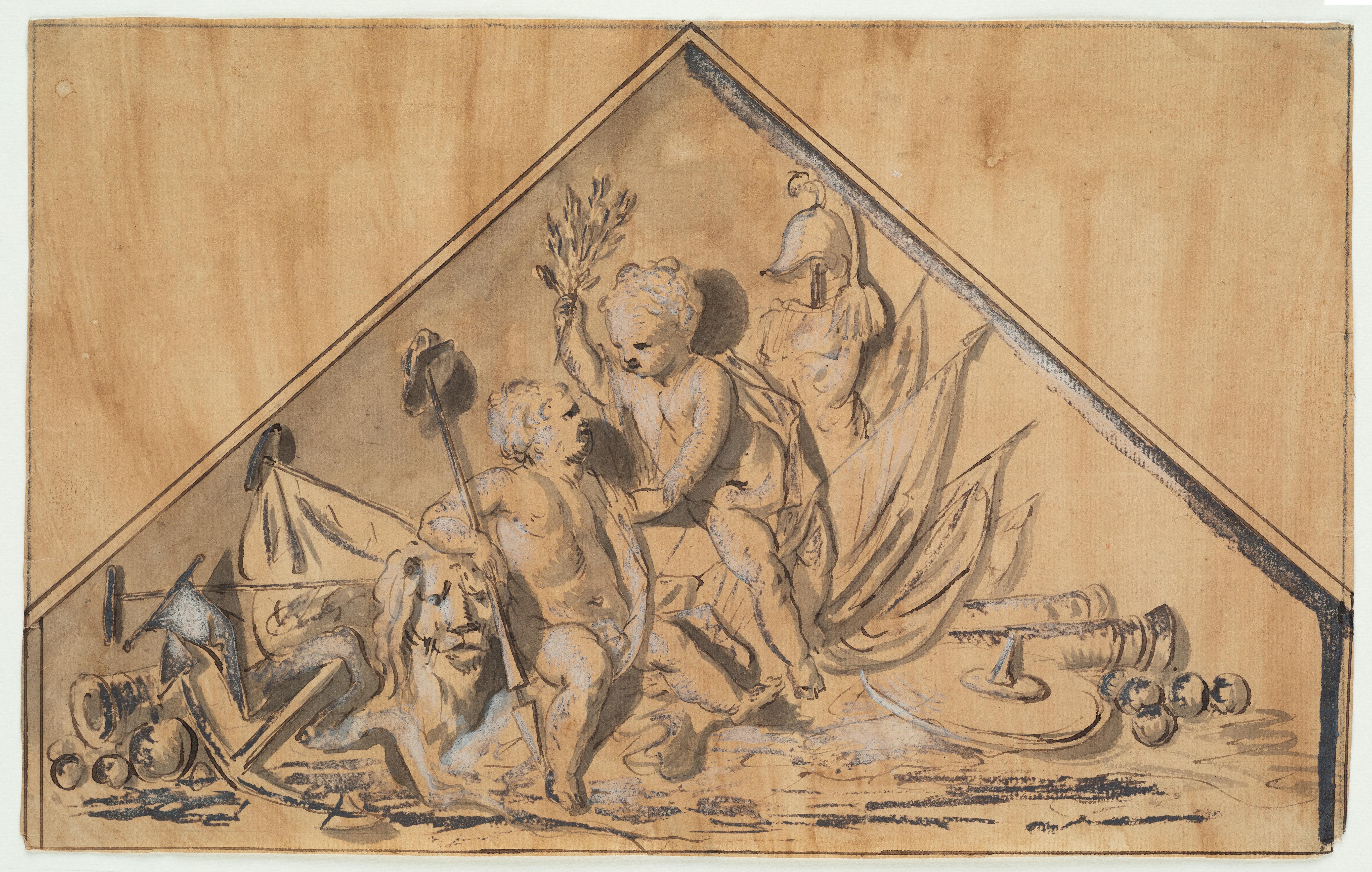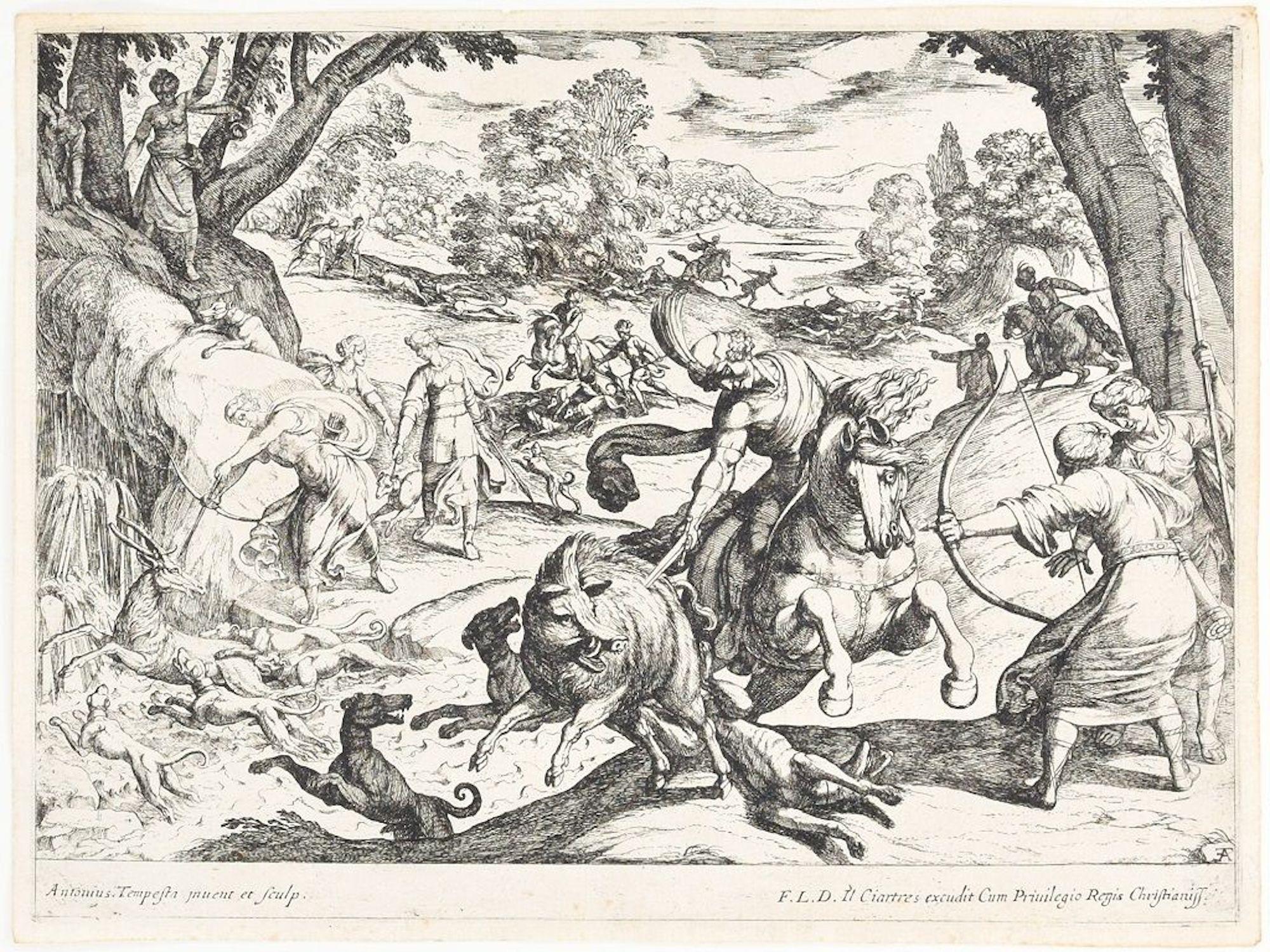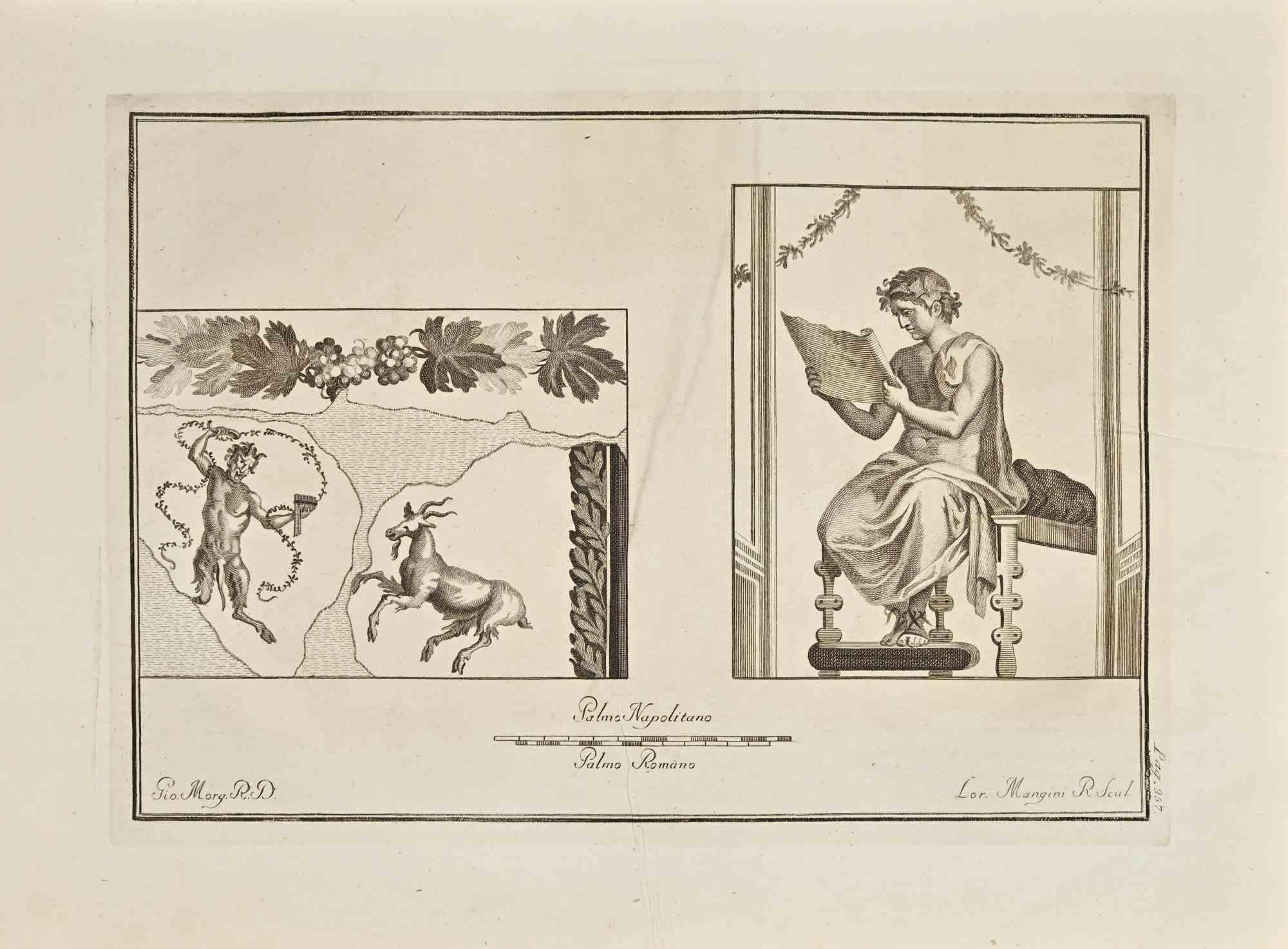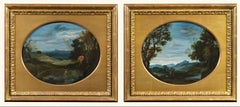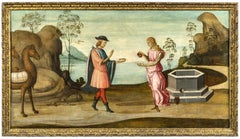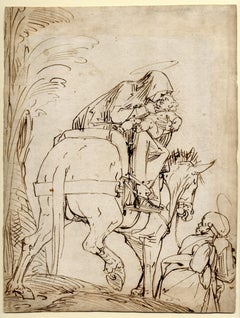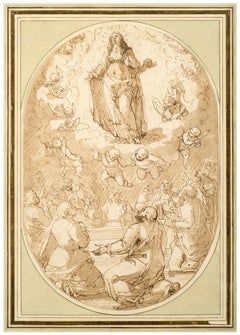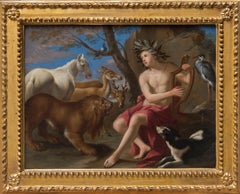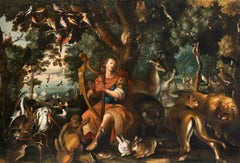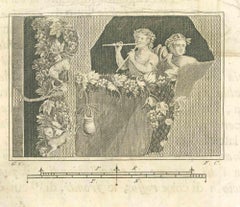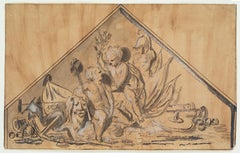Items Similar to Orpheus and the Animals, A Study after an Ancient Bas-Relief
Want more images or videos?
Request additional images or videos from the seller
1 of 3
Bernardino CapitelliOrpheus and the Animals, A Study after an Ancient Bas-Relief1626-1629
1626-1629
$35,000
£26,413.54
€30,239.51
CA$49,361.60
A$54,192.89
CHF 28,272.54
MX$655,809.36
NOK 354,352.45
SEK 333,893.18
DKK 225,729.85
About the Item
Inscribed “55” and “218” in the lower right
Watermark: Heawood 1351
Laid down on historic Cassiano Del Pozzo mount
(Mount Type A, 531 x 402 mm)
Provenance:
Commissioned by Cassiano dal Pozzo (1588–1637) for his Museo Cartaceo (Paper Museum) and kept in the library of his palazzo, via dei Chiavari, Rome
Transferred with the entire dal Pozzo collection by fidecommesso to his younger brother, Carlo Antonio dal Pozzo (1606–1689); by descent to his second son:
Gabriele dal Pozzo (d. 1695); by descent to his wife:
Anna Teresa Benzoni and after her remarriage in 1697, the Marchesa Lancellotti de’ Ginnetti (d. 1736); by descent to their son:
Cosimo Antonio dal Pozzo (d. 1740); by whom sold with the Dal Pozzo library in 1703 to:
Pope Clement XI for the Vatican Library; by whom transferred as part of the Museo Cartaceo in January 1714 to his nephew:
Cardinal Alessandro Albani (1692–1779), Palazzo ‘alle Quattro Fontane’ in Rome; by whom sold in 1762 to:
James Adam, agent for the British Royal Librarian Richard Dalton (1715–1791)
King George III of England, Buckingham House
Among the sheets of the ‘Museo Cartaceo’ appropriated by Richard Dalton during a reorganization of the drawings, circa 1786-1788; his estate sale, Greenwood’s, London, 11-19 May 1791; where acquired by:
John MacGowan (d. 1803), lawyer and antiquary of Edinburgh; his sale, Thomas Philipe, London, 26 January-4 February 1804; where acquired by:
Charles Townley (1737–1805); and by descent to:
John Townley (1803–1876); his sale, Sotheby, Wilkinson & Hodge, London, 10-11 May 1865, part of lot 406, purchased by Thorpe (£5.5s)
Sir William Stirling-Maxwell (1818–1878), 9th Baronet of Pollock, acquired by 1871 and bound in an album entitled “Drawings by Italian Old Masters. Sculpture;” and by descent:
Stirling-Maxwell family; their sale, Phillips, London, 12 December 1990, lot 259, where acquired by:
Private Collection, New York
Exhibited:
“I segreti di un collezionista: le straordinarie raccolte di Cassiano dal Pozzo: 1588-1657,” Rome, Galleria Nazionale d’Arte Antica, Palazzo Barberini, 29 September – 26 November 2000, pp. 137-138, cat. no. 147, as Bernardino Capitelli.
Literature:
Amanda Claridge and Eloisa Dodera, “Sarcophagi and Other Reliefs,” Part III, 3 vols., in The Paper Museum of Cassiano dal Pozzo, ed. Arthur MacGregor and Jennifer Montagu, Series A, Antiquities and Architecture, London, 2019, cat. no. 508, pp. 782-784.
This impressive drawing was commissioned by Cassiano dal Pozzo, one of the most significant patrons and collectors in 17th-century Italy. Dal Pozzo was an internationally known scholar of antiquities and natural history, interests that grew out of his connections to the Medici court in Florence and the intellectual circles centered at the University and Botanical Gardens in Pisa. Dal Pozzo achieved considerable success in his lifetime, serving as a secretary to Cardinal Francesco Barberini and accompanying him on several diplomatic missions. He is now remembered and celebrated for his incredibly ambitious project called the Museo Cartaceo, or the Paper Museum, to which this drawing originally belonged. Dal Pozzo employed artists to draw copies after all surviving remnants of Roman civilization, and to a lesser extent, after various types of naturalia, creating a visual encyclopedia of the ancient and natural world. Not only was the Museo Cartaceo an important resource for study and research in seventeenth century Europe, but after dal Pozzo’s death, it also became a treasured possession of popes and kings.
Although this drawing was previously thought to depict an ancient gem or cameo, it was in fact drawn after an ancient marble relief of Orpheus charming the animals, now in the collection of the Louvre (Fig. 1). While it is often been difficult to identify the whereabouts of ancient objects depicted in Museo Cartaceo drawings at the time that they were made, the location of this relief in the 17th century is well-known. It had been purchased from the artist Pietro Tami—who may have restored the work, setting it into its rectangular surround—in 1615 by Asdrubale Mattei, a Roman nobleman and an important patron of Caravaggio. Mattei installed the relief on the eastern wall of the courtyard in his residence, Palazzo Mattei di Giove, above the third ground-floor window from the south wall (Fig. 2). In the 19th century, the relief was acquired by Cardinal Joseph Fesch and was later in the storied collection of the antiquarian Giampietro Campana, which was eventually purchased by Napoleon III for the Louvre.
According to Greek mythology, the poet Orpheus was able to charm animals and suppress their instinctive ferocity with the sweet sound of his lyre. Orpheus sits in the center of this relief playing his lyre with a plectrum while a group of docile creatures gather around him. Lions, wolves, and a cow lie at his feet, while horses, deer, birds, and two braying mules stand around him, responding to his song. Our drawing, which is roughly one-fifth the size of the relief, faithfully imitates the oval shape of the stone and the original form of the lyre, which has since been restored. The draughtsman seems to have interpreted the tree on which the bird in the upper right of the relief is perched as a branch being consumed by the horned deer. Two other seventeenth-century drawings after the relief of Orpheus charming the animals from the Palazzo Mattei di Giove were made for the Museo Cartaceo and are now in the Royal Collection, Windsor (Figs. 3-4). Our version is the most faithful and accomplished of these drawings.
The present work, which is still in its original dal Pozzo mount, was drawn by an artist that executed numerous drawings for the Museo Cartaceo in the 1620s. Nicholas Turner attributed the drawings from this group to Bernardino Capitelli, a Sienese artist who is known to have been in Rome from 1626-29 reproducing ancient monuments for dal Pozzo. Capitelli dedicated several of his etchings to the dal Pozzo family, and a surviving letter from the Italian painter Giovanni Battista Giustammiani testifies to his time in the service of Cassiano. Francesco Solinas accepted the attribution of this sheet to Capitelli in the 2000 Cassiano dal Pozzo exhibition, but the attribution of this group of works to Capitelli has recently been questioned. However, Amanda Claridge, author and editor of the forthcoming volume on Sarcophagi and Other Reliefs from the Cassiano dal Pozzo catalogue raisonné has suggested that the Capitelli’s authorship of this drawing remains a possibility.
The present drawing was likely removed from the Bassi Relievi Antichi albums of the Museo Cartaceo (Royal Collection, Windsor, ten albums, RCINS 970364-970373), which comprised drawings of ancient relief sculptures. It was later in the collection of William Stirling-Maxwell along with 221 other drawings from the dal Pozzo collection. Stirling-Maxwell’s drawings were either already bound or rebound by him into two albums: “Architecture” and “Sculpture,” to which ours belonged. The tiny holes from this binding (or possibly the original one) are still visible along the upper edge of the mount. The drawing also bears two dal Pozzo numbers: the ‘55’ within the drawing of the relief almost certainly refers to its place in the Bassi Relievi Antichi album and the ‘218’ outside the border of relief (the normal position for dal Pozzo numbers) fits into sequence of drawings attributed to Bernardino Capitelli and may date from the reorganization of the Museo Cartaceo by Carlo Antonio dal Pozzo following Cassiano’s death.
We are grateful to Amanda Claridge for her assistance in cataloguing this drawing.
- Creator:Bernardino Capitelli (1589 - 1639)
- Creation Year:1626-1629
- Dimensions:Height: 5 in (12.7 cm)Width: 6.75 in (17.15 cm)
- Medium:
- Movement & Style:
- Period:
- Condition:
- Gallery Location:New York, NY
- Reference Number:1stDibs: LU1026275981
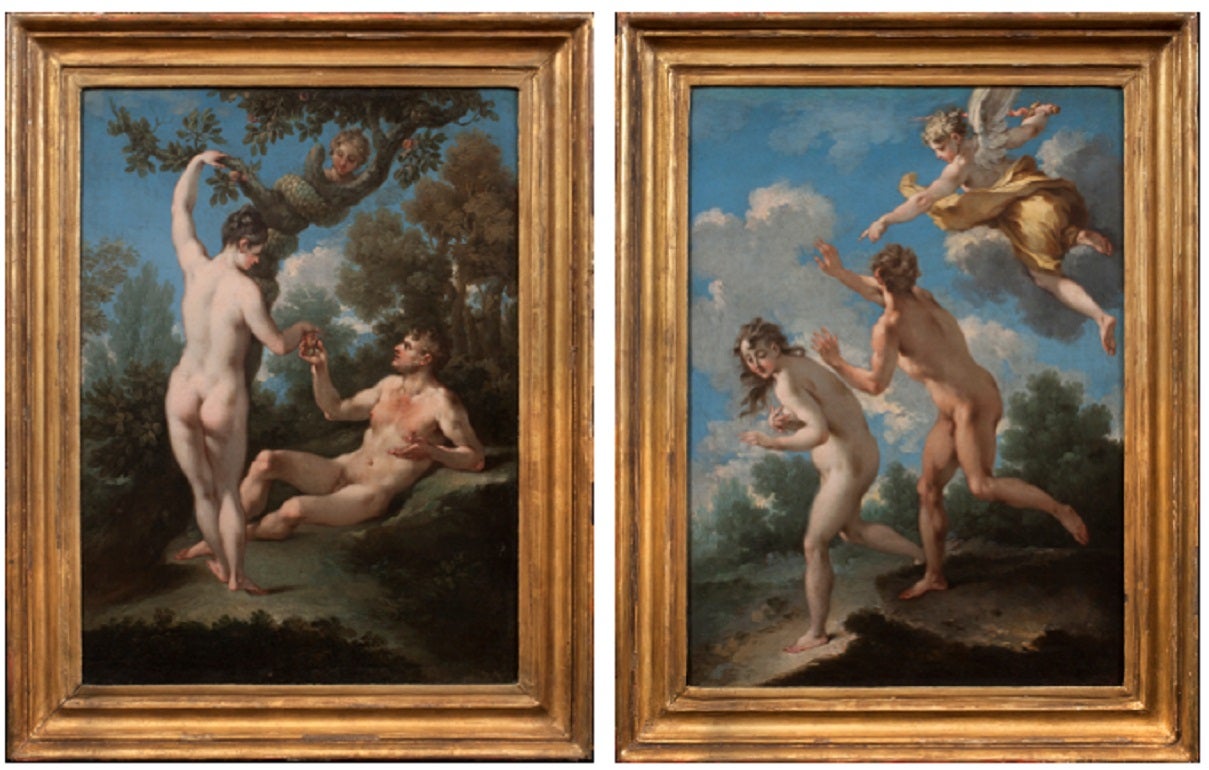
About the Seller
5.0
Recognized Seller
These prestigious sellers are industry leaders and represent the highest echelon for item quality and design.
Established in 1997
1stDibs seller since 2012
22 sales on 1stDibs
Typical response time: 20 hours
- ShippingRetrieving quote...Shipping from: New York, NY
- Return Policy
Authenticity Guarantee
In the unlikely event there’s an issue with an item’s authenticity, contact us within 1 year for a full refund. DetailsMoney-Back Guarantee
If your item is not as described, is damaged in transit, or does not arrive, contact us within 7 days for a full refund. Details24-Hour Cancellation
You have a 24-hour grace period in which to reconsider your purchase, with no questions asked.Vetted Professional Sellers
Our world-class sellers must adhere to strict standards for service and quality, maintaining the integrity of our listings.Price-Match Guarantee
If you find that a seller listed the same item for a lower price elsewhere, we’ll match it.Trusted Global Delivery
Our best-in-class carrier network provides specialized shipping options worldwide, including custom delivery.More From This Seller
View AllTwo Scenes of Diana and Actaeon (a pair)
By Giovanni Battista Viola
Located in New York, NY
Provenance:
Robert L. and Bertina Suida Manning, New York, until 1996
Private Collection, USA
Giovanni Battista Viola was born in Bologna a...
Category
17th Century Baroque Landscape Paintings
Materials
Copper
Rebecca at the Well
Located in New York, NY
Provenance:
Dr. James Henry Lancashire, Manchester-by-the-Sea, Massachusetts, by 1925; probably by descent to:
Private Collection, Cumberland Foreside, Maine, until 2018
This unpublished panel is a characteristic work of the Master of the Apollo and Daphne Legend, an anonymous Florentine painter in the circle of Bartolommeo di Giovanni, Domenico Ghirlandaio, and Sandro Botticelli. The artistic personality of the Master of the Apollo and Daphne Legend was independently recognized by Everett Fahy and Federico Zeri at roughly the same moment in time. Fahy originally dubbed this artist the Master of the Ryerson Panels but later adopted Zeri’s name for the artist, which derives from his eponymous works from the Samuel H. Kress collection (Figs. 1-2). Fahy posited that the artist was most likely a pupil of Ghirlandaio active from roughly 1480 to 1510, and that he may be identifiable with one of Ghirlandaio’s documented pupils to whom no works have been securely attributed, such as Niccolò Cieco, Jacopo dell’Indaco, or Baldino Baldinetti. The present painting was first attributed to this master by Everett Fahy in 1989, who became aware of its existence only after publishing his definitive studies on the artist.
The surviving body of work by the Master of the Apollo and Daphne Legend is largely composed of series of panels treating the same theme. In addition to the works illustrating the legend of Apollo and Daphne, there are also series on the themes of Susanna and the Elders and the story of Saint Joseph, among others. The subject of the present panel is drawn from Genesis 24, the story of Isaac. It is possible that our painting relates to another work by the artist depicting the Sacrifice of Isaac formerly in the collection of E. A. McGuire in Dublin, Ireland (Fig. 3), and that these two panels were originally part of a decorative scheme based on the story of Isaac.
Although the Master’s paintings of this type have traditionally been considered painted fronts of wedding chests, known as cassoni, the scale of these paintings and the fact that they are often part of a series indicates that they are more likely spalliera panels—paintings set into furniture or the wainscoting of a room. The biblical episode depicted in this painting centers on the theme of marriage, which suggests that this work was likely commissioned for the domestic interior of a newly married couple. The Master has transcribed into paint even the minute details of this Old Testament story, in which Abraham sends a servant to travel by camel to the land of his father and seek out a wife for his son Isaac. The servant is here shown at the well...
Category
15th Century and Earlier Old Masters Figurative Paintings
Materials
Oil, Tempera, Wood Panel
The Flight into Egypt
Located in New York, NY
Inscribed: 3. una Madonna che va in Egitto, verso, and Madonna che va in Egitto, recto
Provenance:
Private Collection, UK, since 1999
This expressive and boldly executed drawing is the work of Luca...
Category
16th Century Old Masters Figurative Drawings and Watercolors
Materials
Chalk, Ink, Pen, Paper
The Assumption of the Virgin
Located in New York, NY
Provenance:
Unidentified collector’s mark “D.G.R,” lower right (Lugt 757b)
Wilhelm Suida (1877–1959), New York; by descent to:
Robert L. and Bertina Suida Manning, New York, until 1996
Private Collection, USA
This impressive drawing of the Assumption of the Virgin is the work of the Genoese artist Giovanni Battista Paggi. The son of a nobleman, Paggi received a humanist education and was a self-taught artist. According to Paggi’s first biographer, Raffaele Soprani, it was only after encountering Luca...
Category
16th Century Old Masters Figurative Drawings and Watercolors
Materials
Paper, Ink, Pen
Study after Michelangelo’s “The Last Judgment”
By Michelangelo Buonarroti
Located in New York, NY
Italian School, 16th Century
Provenance:
Private Collection, New York
This intriguing drawing is a study by an anonymous 16th-century Italian artist after a vignette in Michelangelo’s fresco of The Last Judgement in the Sistine Chapel. The altar wall of the Sistine Chapel was already richly decorated when Pope Clement VII commissioned Michelangelo to paint his Last Judgment...
Category
16th Century Old Masters Figurative Drawings and Watercolors
Materials
Paper, Gouache
A Wolf
Located in New York, NY
Provenance:
The Marchesi Strozzi, Palazzo Strozzi, Florence
Sale, Christie’s, London, May 20, 1993, lot 315, as by Carl Borromaus Andreas Ruthart...
Category
17th Century Old Masters Animal Paintings
Materials
Canvas, Paper, Oil
You May Also Like
Orpheus - Original Oil on Canvas Attr. to Tommaso Salini - Early 17th Century
By Tommaso Salini
Located in Roma, IT
Orpheus is an original artwork realized in the first decades of the XVII century and attributed to the Italian master Tommaso Salini.
Oil painting on canvas.
A golden wood frame is...
Category
Early 17th Century Baroque Figurative Paintings
Materials
Oil
Flemish 17th, Orpheus and Animals, Large Decorative Wall Old Master Painting
Located in Greven, DE
Flemish school, 17th century
Orpheus and the animals
Oil on canvas, 146,5 x 217 cm
Provenance: South German private collection.
On an impressive, room-filling format, this painting depicts "Orpheus and the Animals."
The harp-playing Orpheus sits centrally in front of a tree whose trunk bifurcates above his head. This central tree frames with its crown the scenery towards the horizon and at the same time offers through branches the possibility for many birds to find space. The left half of the picture is characterized by a seascape, at the edge of which the ruins of a castle can be seen deep in the background. This seascape, framed by mountains on the horizon, is the only area where sky can be seen. On this side, waterfowl such as storks, swans and ducks can be seen. In the right half, the viewer looks into a deep European forest. On this right side, more land animals can be found, such as deer, rabbits and lions, among others. Orpheus wears opulent red and gold trimmed clothing, under his blue breastplate we see a white shirt. His feet are adorned by elaborate sandals. His head is surrounded by a radiant laurel wreath ("poeta laureatus"). The young man is clearly identifiable as the singer and poet of Greek mythology, Orpheus, by his harp, the laurel wreath and the animals surrounding him.
Orpheus was one of the Argonauts who, under Jason, was searching for the Golden Fleece. He sang so beautifully that he even conquered the angry sea and enemies by the magic of his lyre. During the journey, Orpheus is said to have drowned out even the sirens with his singing. It is said that he was the greatest of all poets and charmed people, animals, stones and trees with his singing.
In total, 51 birds and 37 different species are depicted in the painting. The animals are mostly depicted in great detail and, except for a few, can be identified. Mainly European species of animals are shown. Exceptions are the ostrich-like nandu peeking out from behind the deer, as well as the large parrot on the upper left, and the two lions. Similar is the case for the large animal directly behind Orpheus on the right. The shape of the head suggests an arctic fox from the polar regions, even though the body is much too large. The arctic fox was first described in 1555 by Olaus Magnus. However, it could also be a depiction of a brown or black bear.
An unusual detail is the animal, which is relatively isolated in the right background and looks to the left. It is not clearly identifiable, but it shows certain similarities with the Australian kangaroo. This was first described by Vespucci in 1500 and further by Francisco Pelsaert in 1629. If it is indeed a kangaroo, this would be one of the earliest surviving pictorial representations.
In this painting, Orpheus is accompanied by a small monkey playing a viola da gamba. This is an iconographic peculiarity. In general, this painting has some peculiarities compared to other paintings with "Orpheus and the animals". The central positioning of Orpheus is quite common, but he usually holds a lyre and is dressed in an antique style, but not as opulently. The choice of animals is also remarkable: European animals in particular are seen, hardly any exotic features, such as camels or elephants.
The two lions in the right foreground are a quotation from Peter Paul Rubens and his depiction of "Daniel in the Lion's Den", which was realized in an engraving.
The present painting can be classified as belonging to the Flemish School of the 17th century on the basis of its painterly and compositional conception. From the circle of Jan Brueghel the Younger are numerous representations of this Orpheus - theme, which take it as an opportunity to show as many exotic animals. There are also echoes of Spanish painters such as Juan de Arellano...
Category
17th Century Baroque Landscape Paintings
Materials
Canvas, Oil
Roman Fresco With Mythological Animals - Etching by F. Campana - 18th Century
Located in Roma, IT
Roman Fresco With Mythological Animals from "Antiquities of Herculaneum" is an etching on paper realized by Ferdinando Campana in the 18th Century.
Signed on the plate.
Good condit...
Category
Late 18th Century Old Masters Figurative Prints
Materials
Etching
Old Master Drawing, Baroque, Jacob de Wit, Allegory of Victory, Putti, Ships
By Jacob De Wit
Located in Greven, DE
Two putti with symbols of war and victory (cannons, cannonballs, armour, anchor, lion's head, laurel branch/ olive branch, flag, staff with helmet) in pediment triangle.
Probably a design for a painting or architecture
Pen-and-ink drawing in black on brownish paper, black wash
Plain gold moulding with UV glass
Allegory of Victory, 18th Century, Old Master Drawing, By De Wit, Figurative
Jacob de Wit...
Category
Late 17th Century Baroque Figurative Drawings and Watercolors
Materials
Paper, Crayon
$2,191 Sale Price
35% Off
Hunting Scene - Original Etching by Antonio Tempesta - Early 17th Century
By Antonio Tempesta
Located in Roma, IT
Image dimensions: 20.4 x 27.5 cm.
Hunting Scene is a wonderful black and white etching on thick laid paper, realized by the Italian master, Antonio Tempesta (1555-1630).
Monogramm ...
Category
Early 17th Century Baroque Figurative Prints
Materials
Etching
Ancient Roman Scene - Etching by Giovanni Morghen - 18th Century
Located in Roma, IT
Ancient Roman Scene from the series "Antiquities of Herculaneum", is an original etching on paper realized by Giovanni Morghen in the 18th Century.
Signed on the plate.
Good condit...
Category
Late 18th Century Old Masters Figurative Prints
Materials
Etching
